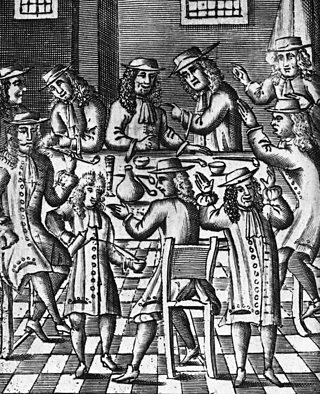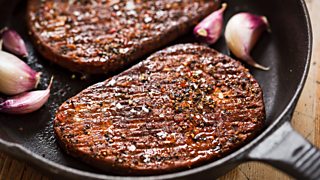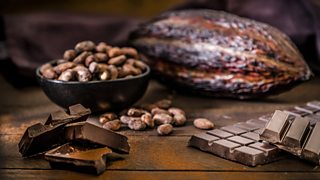How did tea become the nation's favourite drink?
Around 100 million cups of tea are drunk in the UK every day. And all this tea-drinking is big business, with the tea industry on track to be worth a total of £2 billion this year.
There's no doubt about it, in Britain tea is the national drink. But how has this hot infusion made with dried leaves become so ingrained in British culture?
To kick off a new series of 成人快手 Radio 4's All Consuming, marketer and entrepreneur Charlotte Stavrou and science journalist Amit Katwala embark on a journey going back 5,000 years, and travelling as many miles, to discover tea's complicated history and find out how it evolved.
Here's what they uncovered on their thirst-quenching odyssey…

All tea started as green tea
Whether it's a green, oolong or a classic breakfast tea, all tea types come from one plant – the camellia sinensis, an evergreen shrub that can provide a wide variety of flavours depending on how the leaves are processed.

The process of steeping the leaves in hot water started in China about 5,000 years ago. This method itself doesn't draw out much flavour, and so various phases of processing the leaf were established.
"When they realised that the tea plant didn't produce any new leaves in the winter months, they had to devise a way of preserving what they could pick during the growing season," explains historian Jane Pettigrew. "They steamed the leaves to actually capture the green taste, all the enzymes, etc. and so whatever travelled out of China was always green tea."
Black tea came from sweaty soldiers!
Black tea was discovered by total accident. Legend has it that some soldiers out on manoeuvres in the Wuyi mountains of China's Fujian province had bedded down on some tea leaves in a factory. Rather than use the bruised – and probably very sweaty – leaves as normal, one of the factory workers suggested masking any impaired flavour by smoking the leaves.
"They chopped up pine wood and lit a fire to dry the teas," says Jane Pettigrew, "so the teas absorbed some of the smokiness, and when they exported that to their European customers, the customers seemed to like it."
The story of British colonialism is steeped in tea
The first retailer of tea in Britain was coffee shop proprietor Thomas Garway. In 1657, Garway started to sell green tea in one of his London coffee houses.

To get customers interested he distributed a pamphlet that, says Jane, "touted the virtues of tea as a health drink that would make the body active and lusty."
Tea was brought to England and other European nations by the East India Companies. "These trading companies weren't like the global corporations we're used to today," observes Amrit, "they had private armies and even traded in enslaved people.
"Essentially, the English East India Company went hand in hand with British imperialism for more than 250 years."
The diverse make-up of an English breakfast tea is a reflection of the scale of British colonisation.
"A good breakfast tea," says Jane, "is a mixture of Assam tea, which is strong, a malty and smooth, tea from Sri Lanka, which is bright and vibrant, and tea from Kenya or other East African countries which give good colour and real punchy strength to the tea.
"So, there was a clear link between tea and the development of our colonies and how wealthy we became because of exploiting their topography."
Tea and sympathy is a real thing
Tea may have some complicated connotations, but one of its strengths is its association with comfort and support in difficult or traumatic situations.

Clinical and forensic psychologist Dr Andrea Shortland explains that the 'tea and sympathy' tradition "automatically cues your brain to think 'I'm okay, I'm safe now.'" Furthermore, the offer of a cup of tea signifies "perceived social support" and the space to "tell your story", both factors that might even prevent PTSD further down the line. "The taste and smell get to our safety centre in our brain and tell us we're safe before we're even consciously aware," says Andrea.
Studies even suggest that if someone is drinking a hot drink they are much more likely to rate another person more favourably and even offer to help them in some way. "The idea of warmth," explains Andrea, “actually connects when we're physically warm as well as emotionally warm – they're processed in the same part of the brain."
The PG Tips ads reinforced tea as part of the British psyche
The wildly successful ad series that used a family of anthropomorphised chimpanzees to sell PG Tips tea ran from 1956 to 2003. A copywriter hired to raise the profile of the brand hit upon the idea after walking through London Zoo and seeing a 'Chimps Tea Party', where the chimpanzees were dressed in human clothes while they played with a tea set.
Within 18 months of the campaign starting, PG Tips had jumped from fourth in the market to brand leader. "It went on to stay brand leader for the next 40 years," says ad consultant and author Paul Feldwick, who worked on the PG Tips account in the 1990s, "and it still vies for that position today."
The ad was an example of getting an audience to identify with a brand rather than saying why it was better than its competitors. The public did eventually become uncomfortable with how the chimps were used (coinciding with an increasing difficulty in finding a suitable troupe), but the chimps' antics – such as moving pianos, racing in the Tour de France or echoing stories in the news such as the oil crisis of 1973 and the Channel Tunnel dig in 1992 – were an undeniable hit in the bygone days when mass market advertising worked, and they did their bit to reinforce tea as a staple of our culture.
The world is awash with tea
The tea market is a lot more varied than it was when PG Tips started out. For one thing there is the growth in the herbal tea market, non-caffeinated infusions such as chamomile and peppermint teas. This sector is predicted to sell £345.5 million worth of products in the UK this year.
Meanwhile, tea continues to re-invent itself across the globe. In the US, 85% of all tea consumed is iced tea, and in the Far East there is Bubble Tea from Taiwan (making it big in the UK too) which is sweet milky tea with balls of tapioca in it. Then there's Hong Kong milk tea, which uses super sweet condensed milk. This tea has even lent its name to a virtual pro-democracy movement – the Milk Tea Alliance – across Hong Kong, Taiwan and Thailand. Tea and politics, it seems, is as ingrained as tea and sympathy!
To find out more about Charlotte and Amit's adventures in the world of tea, listen to the episode in full here.
The information contained in this article was correct at the time of broadcast on 20 July, 2023.

More articles from 成人快手 Radio 4
-
![]()
Can you feel drunk without drinking alcohol?
Exploring the past, present and future of the non-alcoholic drinks market.
-
![]()
Just how healthy are plant-based meat alternatives?
Looking into how good processed vegan, plant-based products are for us.
-
![]()
Is bottled water better for you than tap?
How bottled brands compare with the water we get straight from the tap.
-
![]()
A history of chocolate in 10 quick facts
You're Dead to Me delves into the past of our favourite confectionery.





